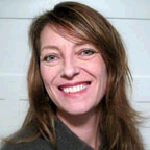Ubiquitous IA
Short Session, presented by Samantha Starmer.
Peter Morville and Andrea Resmini have raised the challenge of thinking about Information Architecture across channels, modalities and experiences.
I will present the next steps practioner viewpoint and recommendations on how to make Ubiquitous IA a reality, using my experience from a top US retailer and my successes at evangelizing ubiquitous IA.
Samantha Starmer
 Over the last 12 years, Samantha
Starmer has worked on a wide variety of user experience and
information architecture projects and strategy while at
Amazon.com, SchemaLogic and Microsoft. She is currently a
senior manager at REI.com, where
she is creating and leading new teams for user experience and
information management, and incubating work around
multi-channel customer experience. Samantha also teaches
information architecture at the University of Washington’s
Information School.
Over the last 12 years, Samantha
Starmer has worked on a wide variety of user experience and
information architecture projects and strategy while at
Amazon.com, SchemaLogic and Microsoft. She is currently a
senior manager at REI.com, where
she is creating and leading new teams for user experience and
information management, and incubating work around
multi-channel customer experience. Samantha also teaches
information architecture at the University of Washington’s
Information School.
You can find Samantha on Twitter as @samanthastarmer.
Some Q&A with Samantha
- What have you been working on lately?
- I’ve been spending a lot of time thinking about the holistic customer experience – or how to design the best possible experience across channels and touchpoints so that people can complete their goals in streamlined, engaging and satisfying ways. The rise of the iPhone and now the iPad obviously changes how we think about websites, but I think that the ubiquity and growth of this kind of technology also means we have to start thinking of unified experiences across the physical and digital. Because I work at a company that has had a very strong physical presence for over 50 years, I am lucky have the opportunity to actively contribute to improving those unified experiences.
- What has been the biggest change with what you do in the past 5 years?
- The bulk of my time these days is spent evangelizing and socializing efforts to improve customer experience, vs. being the one designing those improvements. I’m fortunate to have awesome teams doing information architecture, user experience, interaction design, experience research and analytics, and they do the heavy lifting on creating great experiences. I try to clear brush away so that they can do that work and have it make a positive impact. I try to get tangible support via things like money and headcount, and less tangible support via building relationships and always finding better ways to communicate the value of customer experience. Sometimes it’s hard not being as involved with the day-to-day designing and problem solving, but I try to focus my efforts on empowering my team and getting myself and any roadblocks out of the way.
- What project that you were involved with are you most proud of?
- Wow, that is a tough question because there is probably one at each job I’ve been in, and they are all very different. I guess most recently I would have to say the creation and growth of a team and discipline focused on improving user’s experiences. We always did great work thinking about the customer and trying to design with them in mind, but in the last year, we have made incredible progress in prioritizing resources, budget, and projects that directly benefit a holistic customer experience. Being able to build on work that many other people had done before me to evangelize for the customer and feel like we are truly making a difference is incredibly rewarding.
- What do you think will be the next big thing?
- There are so many ‘next big things’ happening in the technology space these days that I think the next big thing our field needs to think about is how to tie it all together. It isn’t enough any more to design a good website – we have to think about how people hear about our website, get to the website, whether they tell their friends and family, how they interact with our brand/company in ways other than the website. The gap between physical and digital is becoming blurred; as devices integrate with each other and the real world, we must design for this integration and blurring. I think of this as ‘designing for the space between’ – i.e. designing the space between touchpoints, devices and channels, in order to create the most compelling and satisfying experience.
- David says the next big challenge we‘ll face is “a radical overhaul of information design processes that will affect how UX IA and ID professionals work in an environment that demands sustainability and measurable outcomes“. Do you agree, and what are you doing about this?
- In my experience, there often aren‘t enough information design processes in place to necessarily need an overhaul; instead, any emerging processes will require consideration of sustainability and data driven measurement/decision making. But maybe I‘ve worked at places low on the information maturity curve.
Do you have any questions for Samantha or any of our other speakers?
